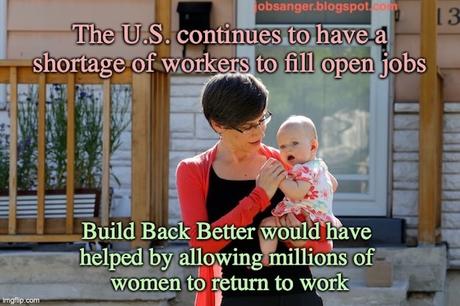
While 6.4 million jobs were filled by workers in the last year, millions of other jobs remain unfilled. One reason is that millions of women remain out of the workforce because of issues like the lack of affordable child care. The Build Back Better Bill would have solved this problem, but too many senators refused to vote for it. They would rather complain that vote for solutions that would let women return to work.
Here is how the situation is described by Heather Long in The Washington Post:
If two years of pandemic life has taught us anything, it is that the United States urgently needs its own version of Japan’s “womenomics,” an effortto boost women in the workforce.
Omicron January has offered yet another reminder that parents, especially moms, are at a breaking point — over inadequate child care, intermittent schooling and the challenges of work, whether remote or in-person. It’s also been a warning about what happens when the U.S. economy doesn’t have enough workers: Growth slows as businesses are forced to cut hours or shut entirely. The 24-hour diner becomes the 16-hour place.
The irony of the moment is that at precisely the time when U.S. policymakers should think bigger about remaking the workplace to meet the needs of women, we are going in the wrong direction. The impending demise of Build Back Better threatens initiatives such as paid parental leave, more subsidies for child care and universal prekindergarten.
Addressing these long-standing problems is not just a matter of doing something nice for women, children and families — it’s good for the overall economy. There’s an immediate need to keep more women from quitting (or forgoing promotions) because they are burned out, but there’s also a longer-term imperative to make it easier for more women to be part of the paid workforce in the years to come.
With baby boomers retiring, the United States is likely to be short on workers for years. Immigration would help, but so would policies that specifically target enabling more women to work.
The United States used to be a global leader in advancing women in the workforce, but that’s not true anymore. In 1985, the United States was behind only Sweden in the share of women working. By 2019, the nation had fallen to 23rd, according to the Organization for Economic Cooperation and Development.
Other nations have eclipsed the United States by following a formula: Offer flexibility, child care and paid parental leave.
In the short-term, parents need flexible scheduling from their employer to get through these covid-19 crunch periods. But to really change the game for women will require nationwide policies.
Japan launched womenomics in 2013 to try to increase the number of Japanese women in the formal workforce. It was far from perfect, but Japan’s female labor force participation rate soared above the United States and many European countries.
The core of womenomics was 14 weeks paid maternity leave, more government-subsidized child care, tax reforms to incentivize work and goals to prod employers to promote women to management ranks and to encourage men to take paternity leave.
For years there have been calls to do something similar in the United States, not to mention outrage that the United States is one of only seven countries in the world without any mandated paid maternity leave. McKinsey and S&P Global — hardly left-leaning institutions — have produced reports arguing that the key to boosting U.S. economic growth is to get more women into the paid workforce.
That urgency has only grown after the pandemic’s toll on the nation. Overall, the share of Americans working or looking for work is near the lowest levels since the 1970s. Put another way, there are 2.3 million fewer people working now than pre-pandemic, and more than half are women.
It’s a major red flag that day cares are at only 90 percent of normal staffing levels and schools are in dire need of bus drivers and substitute teachers, among other positions.
The Build Back Better package was supposed to go a long way toward addressing these problems.
“Probably the single biggest thing Build Back Better could do for the economy is boost women’s labor force participation,” said Adam Posen, president of the Peterson Institute for International Economics and a former adviser to the Japanese government.
But now it’s become “Build Back Smaller.” The measure has to be pared down significantly, if anything passes at all. There still seems to be momentum for universal pre-K, but other child-care efforts are in limbo and paid family leave looks likely to be cut.
“The reason this is not a top priority is this is invisible work that gets done by generation after generation of American women,” said Alicia Sasser Modestino, associate professor at Northeastern University who has done extensive research on the impact of the pandemic on women.
There are trade-offs to any policy decisions, but let’s be blunt: America is once again on the verge of leaving women behind. That’s going to hurt families and the entire economy for years to come.

